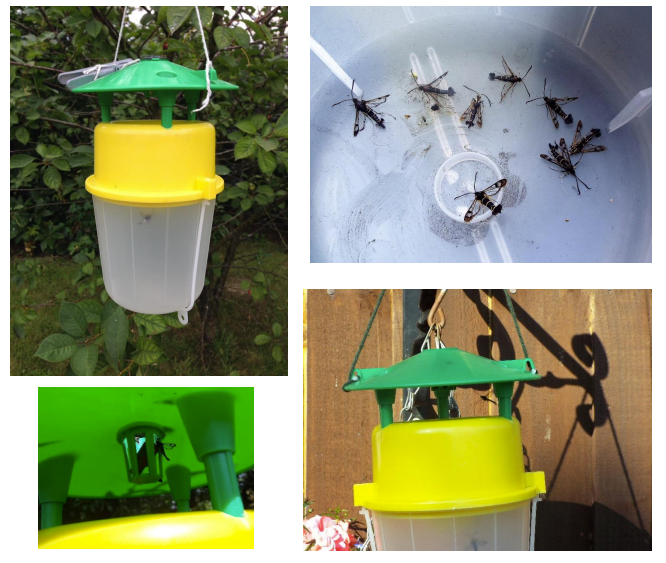PH47 Small Pheromone Trap
NEW Small Pheromone Trap dimensions of complete trap H205xW123mm - The cage is 50 mm in length and 27mm at its widest point - Trap only lures available separately
*Please note, when buying Emperor Moth Lures, they cannot be used with pheromone traps, the moth is too large for the opening and will damage their wings*
NEW Small Pheromone Trap dimensions of complete trap H205xW123mm - The cage is 50 mm in length and 27mm at its widest point - Trap only lures available separately
*Please note, when buying Emperor Moth Lures, they cannot be used with pheromone traps, the moth is too large for the opening and will damage their wings*
NEW Small Pheromone Trap dimensions of complete trap H205xW123mm - The cage is 50 mm in length and 27mm at its widest point - Trap only lures available separately
*Please note, when buying Emperor Moth Lures, they cannot be used with pheromone traps, the moth is too large for the opening and will damage their wings*
PH47 Small Pheromone Trap Instructions for Use
If a damp sponge is to be used, then add to the bucket first
Attach the funnel to the bucket by aligning the slots on the funnel with the tabs on the bucket and twisting to lock together.
Attach the lid to the funnel by aligning the 4 inserts in the lid with the 4 pegs projecting from the top of the funnel. Carefully push the pegs into the holes so that the lid is fully attached.
Remove the cap off the lure cage and place a pheromone dispenser inside. Refasten the cap.
Push the lure cage through the hole in the lid from above so that the cage effectively hangs below the lid.
Thread the supplied hanging cord through the two tab-holes on the lid and tie at both ends
Hang the trap from a support such as a twine trestle, post or tree branch. Check the recommended trap positioning for the moth to be trapped.
Specification
The small pheromone trap system consists of five parts:
Bucket: Constructed from polyethylene with a thickness of 2mm. Dimensions of 95 mm high and 122 mm in diameter.
Funnel: Constructed from polyethylene with a thickness of 2mm. Dimensions of 68mm high and 123 mm wide (not including 38mm high pegs used for affixing lid). The funnel has an internal diameter of 65 mm at its widest point and 30 mm wide at its narrowest point.
Lid: Constructed from polyethylene with a thickness of 2mm. The lid is 116 mm wide with four 12 mm sockets to affix to the pegs on the funnel. On the top are two eyelets for attaching the hanging cord. A central 22mm wide hole is present to hold the lure cage
Cage with Cap: Both parts constructed from polyethylene. The lure cage is green and the cap transparent. The cage is 50 mm in length and 27mm at its widest point. With the cap attached the length is increased to 52 mm.
Hanging Cord: A textile cord 56 cm in length
Dimensions of complete Trap: 205 mm high and 123 mm wide
Weight of complete trap: 117 g
Searching for clearwings and other species of moths rarely seen at light has become very successful with the help of the synthetic pheromone lure over the past 16 years. The lure is used on warm sunny days with a light wind in likely areas by simply hanging up at about chest height and waiting for the intended target. The use of a pheromone trap (see images) can make this operation much simpler and has the added bonus of allowing the recorder to venture away from the lure leaving it to its own devices. The trap can be operated with the lure in place for short periods of time such as a hot afternoon leaving the operator time to do other things. If left for more than a few hours any insect in the trap can become dehydrated so inspection is required at regular intervals (use of a damp egg carton or sponge cut into small pieces can be left in the bottom of the trap to give some moisture). I have left traps in nearby gardens and woodland visiting every few hours and can give very good results which may be missed if using just the lure on its own. The tortrix moth Grapholita lobarzewskii (Kent Fruit Piercer) was caught this way in 2017 and was new to Norfolk. To operate, simply place the lure in the cage at the top of the trap (full instructions are provided with traps when purchased). Hang in a suitable location and re-visit at regular intervals to release any insects caught. If using more than one lure, wash the holding cage thoroughly before adding a different lure otherwise cross contamination can occur.
Jon Clifton - Anglian Lepidopterist Supplies Photographs reproduced with kind permission from Matthew Casey and Rob Edmunds







